The network diagram tools and commands are available on the Data tab of the Utility Network and Trace Network tab sets and are also on the Network Diagram home and contextual tabs.
Utility Network and Trace Network tabs
The contextual Utility Network tab becomes available when there is a utility network layer in the active map.

The contextual Trace Network tab becomes available when there is a trace network layer in the active map.

In both cases, you can find the network diagram tools on the Data tab. They are split into the following two groups:
Network Diagram home and contextual tabs
The Network Diagram home tab becomes available when you are in an active diagram map view. By default, any newly generated diagram or existing diagram you open using the standard workflows displays in a diagram map view.
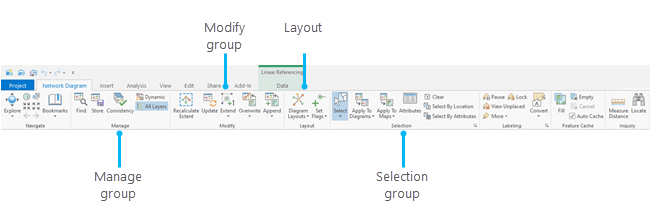
The Data contextual tab under the Network Diagram tab becomes available when the active map view is not a diagram map but references a diagram layer and this network diagram layer (or a layer under this network diagram layer) is selected in the Contents pane for the active map view:
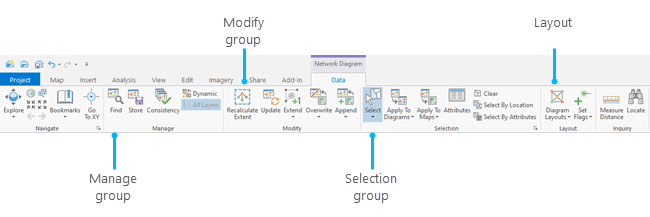
Network diagram tools and commands on the Network Diagram home and contextual tabs are split into the following four groups:
- Manage—Groups the commands that allow you to manage your diagrams.
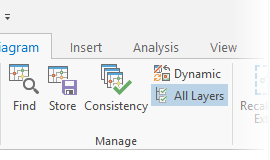
Command Description Enabling condition Find Opens the Find Diagrams pane, where there are functions you can use to search for diagrams related to the active utility network or trace network.
Store Opens the Store Diagram tool, which allows you to store the active temporary diagram long term in the database.
The active diagram is not already stored; that is, it is temporary, the Dynamic mode is turned off, and the template related to the diagram enables diagram storage.
The active diagram layer is from either a utility network or trace network in a file or mobile geodatabase, or a network diagram service; that is, the tool is disabled when working from a database connection to a utility network or trace network in an enterprise geodatabase.
Consistency Checks the consistency of each open diagram to reflect its current state on the icon that appears next to the diagram layers in the Contents pane.
Dynamic Turns the Dynamic mode on or off for the active temporary diagram. When running in Dynamic mode (Dynamic mode on), each time the set of network features or network objects currently selected in the network map changes, the active diagram content is dynamically overwritten to reflect the selection change.
The active diagram is not already stored; that is, it is temporary.
The active diagram layer is from either a utility network or trace network in a file or mobile geodatabase, or a network diagram service; that is, the tool is disabled when working from a database connection to a utility network or trace network in an enterprise geodatabase.
All Layers Turns the All Layers mode on or off for the active diagram. When running in All Layers mode (All Layers mode on) for a diagram, all layers are present in the Contents pane whether they contain diagram features or not. When All Layers mode is off for the diagram, only the layers containing diagram features are present in the Contents pane.
- Modify—Groups the commands that allow you to control the contents of your diagram.
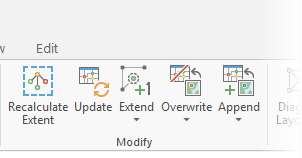
Command Description Enabling condition Recalculate Extent Recalculate the active diagram extent.
There are no unsaved edits.
The active diagram layer is from either a utility network or trace network in a file or mobile geodatabase, or a network diagram service; that is, the tool is disabled when working from a database connection to a utility network or trace network in an enterprise geodatabase.
Update Updates the active diagram.
There are no unsaved edits.
The active diagram layer is from either a utility network or trace network in a file or mobile geodatabase, or a network diagram service; that is, the tool is disabled when working from a database connection to a utility network or trace network in an enterprise geodatabase.
Extend Extends the active diagram one level with regard to connectivity, traversability, containment, or attachment.
There are no unsaved edits, the All Layers mode is turned on for the active diagram layer, and the diagram is not already stored; that is, it is temporary, and the template related to the diagram is enabled to extend diagrams.
The active diagram layer is from either a utility network or trace network in a file or mobile geodatabase, or a network diagram service; that is, the tool is disabled when working from a database connection to a utility network or trace network in an enterprise geodatabase.
Overwrite Overwrites the contents of the active diagram with the network features or network objects currently selected in the map.
When there are several open maps, click the drop-down arrow to display a menu and select the map with the network features or network objects that you want to overwrite the diagram. When there is only one open map, you can click the Overwrite button directly.
There are no unsaved edits, the All Layers mode is turned on for the active diagram layer, and the diagram is not already stored; that is, it is temporary.
The active diagram layer is from either a utility network or trace network in a file or mobile geodatabase, or a network diagram service; that is, the tool is disabled when working from a database connection to a utility network or trace network in an enterprise geodatabase.
Append Adds the network features or network objects currently selected in the map to the active diagram.
When there are several open maps, click the drop-down arrow to display a menu and select the map with the network features or network objects to be appended to the diagram. When there is only one open map, you can click the Append button directly.
There are no unsaved edits, the All Layers mode is turned on for the active diagram layer, and the template related to the diagram is enabled to extend diagrams.
The active diagram layer is from either a utility network or trace network in a file or mobile geodatabase, or a network diagram service; that is, the tool is disabled when working from a database connection to a utility network or trace network in an enterprise geodatabase.
- Layout—Groups the tools and commands you need to lay out diagram content.
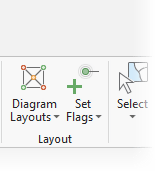
Command Description Enabling condition Diagram Layouts Opens the Geoprocessing pane and loads the active layout algorithm tool—Apply Angle Directed Layout—by default, so you can edit the algorithm parameters, if necessary, before running it.
When the active layout algorithm is not the one you want to execute, click the drop-down arrow under the button to open the algorithm's gallery and select the desired algorithm.
There are no unsaved edits.
The active diagram layer is from either a utility network or trace network in a file or mobile geodatabase, or a network diagram service; that is, the tool is disabled when working from a database connection to a utility network or trace network in an enterprise geodatabase.
Set Flags
Click the drop-down arrow to display a menu and choose the layout tool you want to use:
- Set Root Junction—Designates the junction as a root junction. Root junctions are used by tree layouts, for example, the Main Line Tree Layout. When such junctions are specified, they are placed as starting root junctions for laying out the trees. You can set several junctions as root junctions in the diagram.
- Set End Junction—Designates the junction as an end junction. End junctions are used by the Main Line Tree Layout. When such junctions are specified, they are placed as end junctions of the main line or lines. You can set several junctions as end junctions in the diagram.
- Set Pivot Junction—Designates the junction as a pivot junction. Pivot junctions are needed to run the Rotate Tree Layout. You can set several junctions as pivot junctions in the diagram.
- Set Barrier—Places a barrier on the desired junction or edge. Barriers are used by the Rotate Tree Layout, and they prevent the algorithm from executing beyond them. You can set several barriers in the diagram.
There are no unsaved edits.
The active diagram layer is from either a utility network or trace network in a file or mobile geodatabase, or a network diagram service; that is, the tool is disabled when working from a database connection to a utility network or trace network in an enterprise geodatabase.
- Selection—Groups the commands that allow you to propagate selections to other diagrams or to utility network or trace network maps.
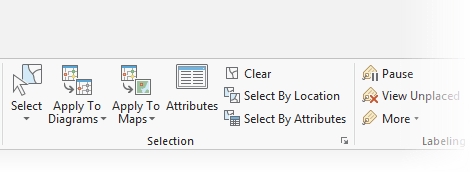
Command Description Enabling condition Select Click the drop-down arrow to display a menu and choose the desired select features tool.
Apply To Diagrams Propagates the active network diagram selection set to other network diagrams that are currently open according to the Network Diagrams Propagation options currently specified.
The command applies to each open diagram, except when you select a particular diagram from the list that displays when you click the drop-down arrow under the command button.
There are features selected in the active diagram, and there are other diagrams open in other maps.
Apply To Maps Propagates the active network diagram selection set to utility network or trace network maps according to the Network Diagrams Propagation options currently specified.
When there are several maps referencing the utility network or trace network, the command applies to each map. However, if you select a particular map from the list that displays when you click the drop-down arrow under the command button, it only applies to that map.
There are features selected in the active diagram, and there are other maps open that reference the utility network or trace network where the diagram resides.
Attributes Opens the Attributes pane, where you can view the attributes of selected diagram features.
This command is always enabled.
Clear Deselects all currently selected features.
There is a set of features currently selected in the active map.
Select By Location Opens the Geoprocessing pane and loads the Select Layer By Location tool, which allows you to select features using the locations of features in other layers.
Select By Attributes Opens the Geoprocessing pane and loads the Select Layer By Attribute tool, which allows you to select features by their attribute values.
Options Opens the utility network or trace network options dialog box with the Network Diagrams tab active, where you can specify different options when working with network diagrams.